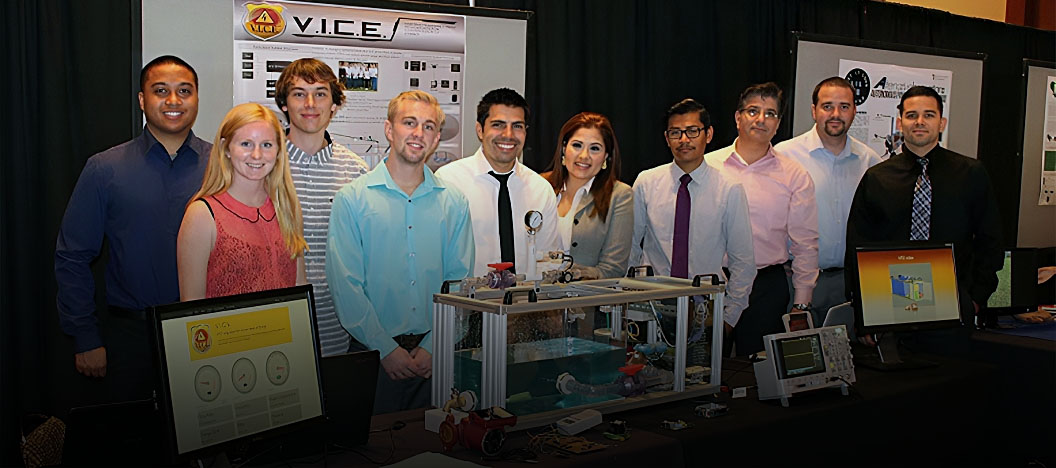Design Day 2023
Engineering Senior Design Day 2023 showcased innovative design projects the undergraduate Engineering students create throughout their academic year. This event is a combination of the Engineering Senior Design classes in Aerospace Engineering, Civil, Construction & Environmental Engineering, Electrical & Computer Engineering, and Mechanical Engineering.
For an in depth look at all of the senior design projects for 2023, please visit our digital 2023 Senior Design Day booklet.
Engineering Senior Design Day 2023 was held in Montezuma Hall on May 3, 2023 from 1:30pm - 4:00pm (PST).
DESIGN DAY PROJECTS

The ARGUS III Remote Wildfire Sensing Program consists of a 10 person team tasked to design and create a functioning device that will assist the US Navy with tracking wildfires for firefighting purposes. The module uses electronics that help track important characteristics of fires such as humidity, temperature, and location. The device is made from 3D printed high impact and heat resistant material, and will be dropped via drone into fire active or prone areas. The design features five sub-assemblies with their own integrated electronics.
- Team Members: Jaime Isaiah Cervantes (ME), Anthony Duyan (ECE), Blake Elliott (ECE), Noah Hinckley (ME), Sonya Loredo (ME), Andrew Mapes (ME), Diana Mudeer (ECE), Philip Phan (ECE), Joseph Solis (ECE), Carson Vogel (ME)
- Advisors: Dr. Scott Shaffar (ME), Prof. Barry Dorr, PE (ECE), Chris Curran (US Navy), Kevin Demesa (US Navy)
- Sponsor: US Department of Defense, National Security Innovation Network (NSIN)
- ARGUS III's Video

The VU (volume unit) meter is designed for users who wish to see a visual representation of audio volume and to aid in refining audio recordings. It will be able to connect to any device that can produce audio via a 1/4" jack and displays peaks of that audio across a frequency spectrum limited to the range of human hearing via LED columns.
- Team Members: David Balderrama Solorio, Richard Chial, Daniel Colmenarez, Ali Noory, Gabriel Sawaya, Elpy Perez
- Advisors: Prof. Barry Dorr, PE (SDSU), Prof. Christopher Warren (SDSU)
- Sponsor: SDSU Electrical & Computer Engineering
- Audio VU Meter's Video

Masimo is a medical device company that manufactures 100 million medical devices each year and is in need of streamlining their current process of inserting adhesive sensors into pouches. To increase the production volume, speed, and accuracy, Team Bondi has designed an automated pouch opener/presenter for Masimo to implement into their facilities. The system uses a Programmable Logic Controller (PLC) and sensors to control the pneumatics in order to grab a pouch from a hopper and then opens and presents the pouch to an operator for sensor insert.
- Team Members: Abulaziz Alali (ECE), Jocelyn Arias (ME), Zachary Conte (ME), Chance Fugleseth (ME), Jessica Grear (ME), Braden Hooper (ECE), Hana Julazadeh (ME), Brayan Lopez Corona (ECE), Thomas Trinh (ECE), Ryan Wilson (ECE)
- Advisors: Dr. Scott Shaffar (ME), Prof. Barry Dorr, PE (ECE), Chris Cardenas (Masimo), Brendan Green (Masimo), Kamyar Khorrami (Masimo), Glenn Pohly (Masimo), Pratul Singh (Masimo)
- Sponsor: Masimo
- Automated Pouch Opener/Presenter's Video
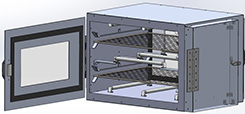
Team LUV Engineering has collaborated with Masimo engineers to design, document, and fabricate a system that emits UV-C light to all sides of various bagged and packaged medical objects for a known and controlled amount of time. Masimo uses UV-C light to disinfect finished medical products in a factory-line environment. This project aims to improve the UV-C disinfecting process that is currently used at Masimo by maximizing throughput and enhancing operational safety.
- Team Members: Tanner Askey (ECE), Nathaniel Guba (ECE), Sara Herrera (ME), Matthew Hui (ME), Lorance Malan (ECE), Davis Owen (ME), Calvin Phan (ME), Lauren Prentiss (ECE), Micaela Rafael (ME), Brayan Rosas Vera (ME), James Scobie (ECE)
- Advisors: Dr. Scott Shaffar (ME), Prof. Barry Dorr, PE (ECE), Braeden Clewis (Masimo), Stanley Chang (Masimo), Austin Pike (Masimo), Glenn Pohly (Masimo), Pratul Singh (Masimo), Jason von Wilpert (Masimo)
- Sponsor: Masimo
- Automated UV Curing/Sanitizing Oven's Video

The Automatic Guitar Tuner is a smart, motorized device that will aid musicians in tuning their guitars accurately and efficiently. This handheld device features a display allowing the user to select the correct string and showcase the frequency being picked up. Smaller LEDs are also included to monitor the tuning status at a glance. The device is connected to a guitar via a standard ¼” Aux connection. The device is held over a tuning knob, the user strums a guitar string, then the motor automatically tunes it.
- Team Members: Ara Jacob, Somer Hanna, Matthew Hughes, Albert Joseph Rodrigo, Eric Taft
- Advisor: Prof. Barry Dorr, PE (SDSU)
- Sponsor: SDSU Electrical & Computer Engineering
- Automatic Guitar Tuner's Video
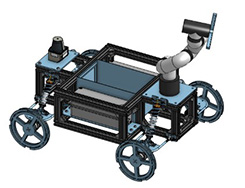
The team is developing a new lightweight space robot that is multi-coordinated robotic system. The robot has the capabilities to be able to access and explore Mar's more challenging sites such as Hellas Planitia. The robot has the ability to exceed the force and payload capabilities to carry 5 times its own mass. It also has the inventive technology of soft robotics allowing for the retrieval of a myriad of samples.
- Team Members: Shahad Al Neesan (ECE), David Aw (ECE), Christopher Choo (ECE), Abelardo Garcia (ME), Cameron Jaynes (ME), Sophie Koehler (ME), Shingo Morita (ECE), Andrew Richter (ME), Martin Ruiz (ECE), Uriel Zamorano (ECE)
- Advisors: Dr. Zahra Nili Ahmadabadi (ME), Dr. Scott Shaffar (ME), Prof. Barry Dorr, PE (ECE)
- Coordinated Multi-Robots for Planetary Exploration's Video

The Filter Frequency Response Visualizer or FFRV is a Bode plot visualizer utilizing analog circuit design to obtain magnitude and phase response of a passive electrical filter. A user of the product will use their computer and a computer interface designed by the team to visualize and then download the frequency response of the circuit as a Somma Separated Value (CSV) file.
- Team Members: Ezra Gonzalez, Trent Moca, Cade Ramirez, Jarrod Rowson, Louise Van Aken
- Advisor: Dr. Ashkan Ashrafi (SDSU)
- Sponsor: SDSU Electrical & Computer Engineering
- Filter Frequency Response Visualizer's Video

The FPGA FM Synthesizer is a replacement for software-aided synthesis. Plugging in a MIDI keyboard, it processes the digital input bitstream and uses fixed-point DSP to output an analog sound wave. It can produce up to 16 voices, note bending, and can generate sine, square, sawtooth and triangle waves. Frequency modulation is done by selecting the amplitude and frequency of a modulating signal. This system uses a System-On-Chip, combining the flexibility of a processor and hardware acceleration of programmable logic.
- Team Members: Abdullah Altawheed, Michael Fallon, Tiber Hernandez, Andres Medina Gonzalez, Tharaa Rahhal, Elisha Reece
- Advisor: Prof. Barry Dorr, PE (SDSU)
- Sponsor: SDSU Electrical & Computer Engineering
- Frequency Modulation Music Synthesizer in FPGA's Video
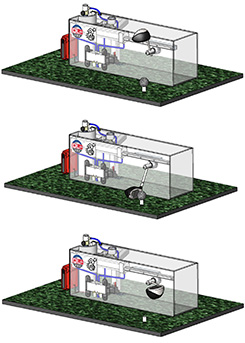
Our innovative device is specifically designed to enable disabled golfers to enjoy the game of golf, even if they cannot swing a golf club. Our goal is to overcome the limitations posed by physical disabilities through a sophisticated mechanical design. With just the press of a button, our device will be able to launch a golf ball down the fairway, using an accessible control mechanism such as a sip-and-puff system. This means that wheelchair-bound users with limited mobility can now participate in this great sport and experience the joy of hitting a golf ball.
- Team Members: Larry Arango (ME), Shakiba Abdul Sattar (ECE), Dominic Bartlewski (ME), Justin Cao (ECE), Briareus Castillo (ECE), Jerrick Claridad (ME), Taiyo Gurule (ME), Tanner Makar (ME), Thomas Marshall (ECE), Tyler-Benjamin Puspos (ECE)
- Advisors: Dr. Scott Shaffar (ME), Prof. Barry Dorr, PE (ECE), Scott Huyvaert (Quality of Life Plus)
- Sponsor: Quality of Life Plus
- Golf Club System for Wheelchair Players's Video
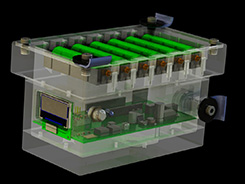
We have developed a compact, fire/water-proof Grounded Low Voltage Battery Power Supply for the SDSU Aztec Electric Racing Team to mount to their competition vehicle. It has a dual output power supply, powered by rechargeable batteries, with a battery management system to protect the electronics; an LCD screen to output live readouts of battery temperature, voltage, and current; and a pushbutton to light up an LED and initiate recording and storing of this data to be analyzed later.
- Team Members: Trevor Arellanez (ME), Bader Alshammari (ECE), Eugenio Casta (ME), Tyler Chu (ECE), Evan Cuyler (ME), Joseph Fraticelli (ECE), Pamela Gallardo (ECE), Jonas Schulson (ME), Jack Topoleski (ME), Cyrus Yousefian (ECE)
- Advisor: Dr. Scott Shaffar (ME), Prof. Barry Dorr, PE (ECE)
- Sponsor: SDSU Aztec Electric Racing
- Grounded Low Voltage Power Supply for an Electric SAE Race Car's Video
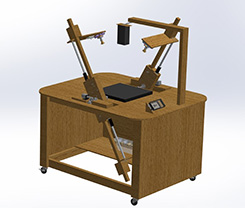
The Horn Antenna Fixture for Network Analyzer is a joint Mechanical, Electrical, and Computer Engineering team project to design, build, test, and document an automated test fixture for a network analyzer used to measure insertion and reflection loss of materials. The test fixture was designed for Laird R&F Products, who develops high-performance materials for the aerospace and defense markets and conducts insertion and reflection loss tests to determine the radio frequency properties of their products.
- Team Members: Peter Marrone (ECE), Caleb Nieto (ME), Conor O'Mahoney (ME), Livar Mikha (ME), John Pateros (ME), Cindy Rios (ECE), Christopher Rodriguez (ECE), Tyler Simmons (ECE), Christian Suatengco (ECE), George Yousif (ME)
- Advisors: Dr. Scott Shaffar (ME), Prof. Barry Dorr, PE (ECE), Sarah Cartwright (Laird)
- Sponsor: Laird R&F Products
- Horn Antenna Fixture for Network Analyzer's Video
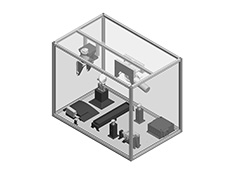
General Atomics Aeronautical Systems is one of the world leaders in the design and manufacture of Unmanned Aircraft Systems, radars, and electro-optic products. The goal of the Mechanical Assembly Display Automation is to manufacture a dynamic display, that will contain, and display the functions of components found within General Atomic-ASI's facilities and products. Users will be able to control the components located within the enclosure to view and understand how these parts operate.
- Team Members: Nathaniel Cordero (ME), Jacob Cutter (ECE), Christian D'Orazio (ECE), Lotanna Ene (ECE), Sinan Kamil (ECE), Alan Ta (ME), Allen Ugalde (ME), David Villareal (ME)
- Advisors: Dr. Scott Shaffar (ME), Prof. Barry Dorr, PE (ECE), Timothy Novinger (General Atomics), Michael Spies (General Atomics), Patrick Veth (General Atomics)
- Sponsor: General Atomics - Aeronautical Systems
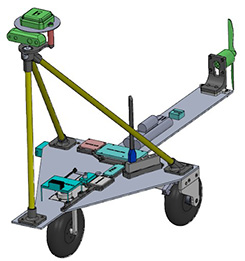
Team Maverick delivers a complex system for General Atomics's MQ-9A drone with their 1/10th scale drone with similar driving, steering, and brake systems utilizing the spiral design model that is capable of a high number of cycles, is low cost, easy to manufacture, and has high maneuverability. The drone incorporates GPS mapping through a UI to steer the drone to the target destination, taxiway line tracking, and object distance detection that brakes or slows depending on the distance detected of an object in view.
- Team Members: Saja Alallao (ECE), Paul Baker (ECE), Andy Galvan (ME), Ezra Garcia (ECE), Alexander Johnson (ECE), Gregor Krzyminski (ME), Sonny Pham (ME), Ofek Suchard (ME), James Winter (ME), Dj Younkin (ECE)
- Advisors: Dr. Scott Shaffar (ME), Prof. Barry Dorr, PE (ECE), David Putnam (General Atomics), Christohper Sam (General Atomics)
- Sponsor: General Atomics
- MQ-9A's Video
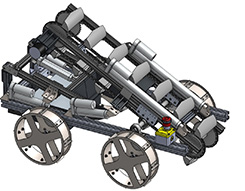
Team VULCAN is representing a joint Mechanical, Electrical, and Computer Engineering team from San Diego State University at the NASA Robotic Mining Competition Lunabotics 2023. The competition’s goal aims to prototype a rover capable of delivery to the moon in order to excavate lunar regolith beneath its surface, serving NASA’s Artemis Mission to the Moon. The rover will be capable of successfully completing a simulated mission of deployment to the moon to collect lunar regolith while avoiding obstacles and craters.
- Team Members: Beqa Abulashvili (ECE), Jared Acosta (ECE), Kevin Breslin (ECE), Hunter Gavin (ME), Leah Lafata (ME), Juan Leyva Carrillo (ECE), Dylan Lomas (ME), Angelina Parker (ME), Ian Phelps (ME), Joshua Putris (ECE)
- Advisors: Dr. Scott Shaffar (ME), Prof. Barry Dorr, PE (ECE)
- Sponsor: NASA
- NASA Artemis 2023 Lunabotics Video

Navicane is an RFID assisted smart cane that will harness passive tags to help navigate the visually impaired indoors. The device will feature an RFID reader assembly that will identify the data coded on door tags, convert it to digital data which will be passed to an embedded microcontroller. The microcontroller will identify the data and pass accurate information over Bluetooth to a smartphone application. This technology will allow for easier and quicker identification of key entrances and exits.
- Team Members: Mike Cao, Sean Clark, Cesar Gonzalez, Yen Pham, Jason Wu
Advisor: Dr. Hakan Töreyin (SDSU)
Sponsor: Dr. Andrew Szeto, Emeritus (SDSU) - Navicane's Video
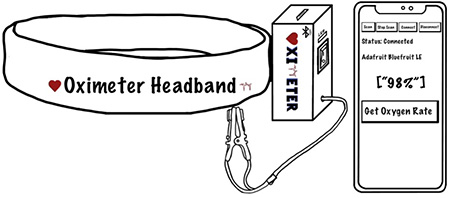
The pulse oximeter is a portable Bluetooth enabled device that uses light measurements to calculate the blood oxygen levels in a person's body. This device had been engineered as an earpiece that measures from the ear as opposed to taking measurements from a finger. Our design is battery operated and rechargeable for continued long term use.
- Team Members: Sarmad Dawood, Sean Doan, Janvincent Gawaran, Michael Martineau, Gabriel Miller
- Advisor: Dr. Hakan Töreyin (SDSU)
- Sponsor: Dr. Andrew Szeto, Emeritus (SDSU)
- Pulse Oximeter's Video
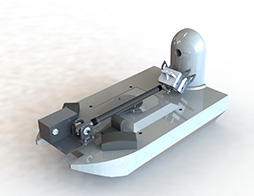
RES3RA is a deck-mounted attachment for Booz Allen Hamilton’s MANTAS (Man-Portable Tactical Autonomous System). The modular attachment will enhance the unmanned surface vessel’s ability to perform reconnaissance and surveillance missions. Currently, the delivery of surveillance payloads is performed by two operatives that jet ski to the target vessel and attach the payload to its hull with a long pole. The RES3RA aims to accomplish the same task in tandem with MANTAS, thus removing operatives from potential danger.
- Team Members: Barry Baker (ECE), Milan Bujosevic (ECE), Andrew da Cunha (ME), Brian Herman (ME), Trent McGill (ME), Nathan Reynolds (ME), Jesus Samaniego Sanchez (ECE), Ackara Seav (ECE), Oliver Shirley (ECE), Nathan Whitford (ME)
Advisors: Dr. Scott Shaffar (ME), Prof. Barry Dorr, PE (ECE)
Sponsor: Booz Allen Hamilton, Troops to Engineers - RES3RA's Video
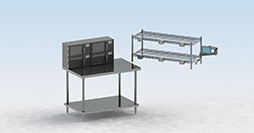
The Smart Cure Cabinet Monitoring System is an electrically integrated cabinet system to be used by Masimo’s production workers to register component information through a barcode system, assign the component a curing location and time, track its curing progress, and indicate the product's curing status to other production workers. Status will be shown by four timer modules attached to the cabinet, along with six others that can be attached to different curing station setups including open racks, cabinets, and ovens.
- Team Members: Abdullah Bin Essa (ECE), Eduardo Burga-Donovan (ECE), Oscar Campos (ME), Matthew Fontimayor (ME), Kendra-Rose Jucal (ME), Samuel Kenny (ME), Luka Kurashvili (ECE), James McGill (ECE), Cody Nephew (ECE), Olivia Orren (ME)
- Advisors: Dr. Scott Shaffar (ME), Prof. Barry Dorr, PE (ECE), Stanley Chang (Masimo), Glenn Pohly (Masimo), Jake Prittie (Masimo), Jasmine Zhang (Masimo)
- Sponsor: Masimo
- Smart Cure Cabinet Monitoring System's Video
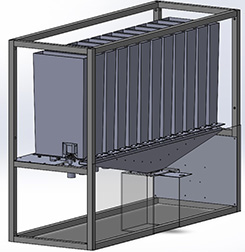
D&K Engineering has enlisted the help of SDSU students in designing a Smart Granola Kiosk capable of accepting user input for payment and ingredient selection. Customers will use an app to place orders via a tablet on the kiosk or through a smartphone via a mobile app. Once an order is placed, the granola then dispenses to the customer via a food safe delivery system. The kiosk will be modular and food safe according to FDA regulations.
- Team Members: Joshua Alanzalon (ME), Rylan Bumbasi (ECE), Jian Cai (ME), Nathan Dockswell (ME), Lauren Halbach (ECE), Dylan Mazzarella (ME), Manuel Medina (ECE), Jarlen Nicholos (ME), Joseph-Gerard Placido (ECE), Rodrigo Sosa (ECE)
- Advisors: Dr. Scott Shaffar (ME), Prof. Barry Dorr, PE (ECE), Dusty Fisk (D&K), Wayne Jackson (D&K), John Reep (D&K)
- Sponsor: D&K Engineering
- Smart Granola Kiosk's Video
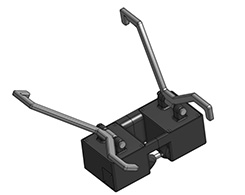
Team Soteria designed and manufactured a payload deployment for search and rescue teams. The goal of the payload is to be able to carry lightweight emergency supplies to remote locations with the use of the current Search and Rescue (SAR) drone, the DJI Mavic 2 Enterprise. The payload is lightweight, portable, and non-intrusive to the drone sensors. The attachment method is interchangeable, and the release mechanism is initiated through audio signals and can be done from any distance the drone can fly.
- Team Members: Alex Aguilar (ME), Adam Campbell (ECE) Nabi Habib (ECE), Sam Halabo (ME), Bryan Kennedy (ME), Riley Livers (ECE), Liam McCue (ME), Mason Stark (ME), Danny Tisnado (ECE), Dylan Van (ECE)
- Advisors: Dr. Scott Shaffar (ME), Prof. Barry Dorr, PE (ECE), Ryan Debusk (Northrup Grumman), Dean Shears (Northrup Grumman), Dave Hendron (SD Sheriff's Dept)
- Sponsor: Northrup Grumman
- UAV Payload Deployment for Search and Rescue Teams's Video

